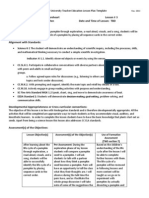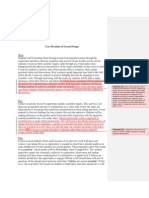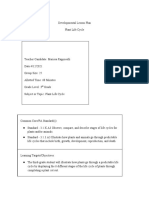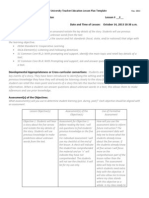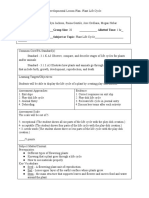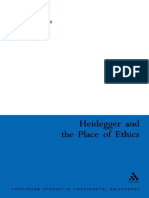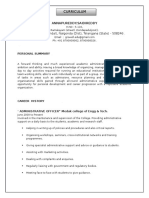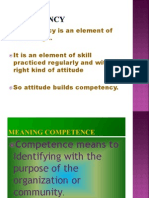Lesson Plan 3 Pumpkins
Lesson Plan 3 Pumpkins
Uploaded by
api-122547405Copyright:
Available Formats
Lesson Plan 3 Pumpkins
Lesson Plan 3 Pumpkins
Uploaded by
api-122547405Original Title
Copyright
Available Formats
Share this document
Did you find this document useful?
Is this content inappropriate?
Copyright:
Available Formats
Lesson Plan 3 Pumpkins
Lesson Plan 3 Pumpkins
Uploaded by
api-122547405Copyright:
Available Formats
Rev.
2013
Teacher Candidate: Jordan Gates Lesson # ___3___ Subject/Grade: Science/1st Date and Time of Lesson: October 29, 2013 Learning Objective: Students will be able to identify 3 out of the 6 stages in the life cycle of a pumpkin. Alignment with Standards: Summarize the life cycle of a pumpkin. (Seed, sprout, vine, flower, green pumpkin, pumpkin) Developmental Appropriateness or Cross-curricular connections: My learning objective is appropriate for my students because it is so close to Halloween that students are already excited about pumpkins. Students need to know the life cycle of a pumpkin, especially this time of year when they go to look at pumpkins. Assessment(s) of the Objectives: Pre: This lesson as a whole will be used for a pre assessment. During: For a during assessment I would teach more about the life cycle of a pumpkin and I would assess the students by doing an anecdotal record sheet to see if the students now would know 4-5 out of the 6 stages of the life cycle. Post: For the post assessment of the life cycle of a pumpkin, I would have the students create a booklet that had each of the stages of the life cycle in order. Lesson Objective Assessment of the Objective Use of Formative Assessment Students will be able to Students will be assessed by I will use the data that I identify 3 out of the 6 an anecdotal record sheet. I collected from my stages in the life cycle of a will check off on how many assessment to form pumpkin. stages of the life cycle of a how I will teach the life pumpkin the students know. cycles of animals later in the year. I can learn from what I am doing here, and modify it to teach later on. Accommodations: For students who are visually or hearing impaired, I will sit them closer to the front of the rug. For students with behavior problems, I will seat them in a seat where they are less likely to get into trouble. Materials: One Large Pumpkin One Large Spoon Garbage bags x2 Bowl of Seeds Student Computers Procedures: 1. I will start off my lesson by calling my students to the rug. 2. I will tell them that we are going to sit in a circle on the rug. Depending on how well the students do on their own, I might have to have students hold hands to make a circle and then sit down.
Rev. 2013
3. The students will take turns touching and getting a closer look at the pumpkin. 4. While the students are taking turns touching and getting a closer look at the pumpkin, I will ask them, What does the pumpkin feel like? What does the pumpkin look like? 5. I will ask the students, Why do you think that pumpkins have seeds? 6. This is where I will begin to introduce the life cycle of a pumpkin. 7. I will give the students a chance to tell me why they think pumpkins have seeds. 8. After everyone has had a chance, I will begin to explain the life cycle of a pumpkin. 9. I will go through the stages in order (seed, sprout, vine, flower, green pumpkin, and pumpkin). I will show them a visual of the stages of the life cycle as I am explaining it. 10. After we have talked about the life cycle of a pumpkin, we will begin our dissection. 11. As we go through the dissection I will talk to the students about what they see. 12. I will also let the student feel the goop of the pumpkin. I will ask students, What does the inside of the pumpkin feel like? 13. I will pull all of the goop out of the pumpkin and place it aside. 14. I will keep the goop and seeds to use for my next lesson. (Math: CCSS.Math.Content.1.NBT.A.1 Count to 120, starting at any number less than 120. In this range, read and write numerals and represent a number of objects with a written numeral.) Activity Analysis:
Anecdotal Record Sheet: This record sheet will have each of the stages of a pumpkin life cycle listed on it. I will be able to check off which of them the students know. I will also keep an anecdotal record sheet that I will check off behavior, following directions, and working well with others. If time allows, I will have students go to back computer to do pumpkin game.
References: Vogan, B. (2013). Pumpkin patch tv. Retrieved from http://www.pumpkinpatchtv.blogspot.com/2012/09/thats-how-pumpkin-grows.html
You might also like
- Life Cycle of A Pumpkin Lesson PlanDocument3 pagesLife Cycle of A Pumpkin Lesson Planapi-524919792No ratings yet
- Instrucational Resources Chart Artifact 2Document2 pagesInstrucational Resources Chart Artifact 2api-122547405100% (2)
- Lesson Plan 3 Pumpkin Life CycleDocument3 pagesLesson Plan 3 Pumpkin Life Cycleapi-177768681No ratings yet
- Soil Lesson PlanDocument6 pagesSoil Lesson Planapi-295505041100% (3)
- Our Granny ES1Document26 pagesOur Granny ES1S TANCREDNo ratings yet
- Kindergarten Measurement Lesson PlanDocument4 pagesKindergarten Measurement Lesson Planapi-351597723No ratings yet
- TCNJ Lesson PlanDocument19 pagesTCNJ Lesson Planapi-274162408No ratings yet
- The Lorax Lesson PlanDocument11 pagesThe Lorax Lesson Planapi-235734674100% (1)
- Agpoon Pe4 Acei 2 2 Evidence (No Name)Document8 pagesAgpoon Pe4 Acei 2 2 Evidence (No Name)api-243096365No ratings yet
- Long Form Lesson Plan Template: Name: Lauren Checker Date: 4/23/15 Content Area(s) Scientific Thinking Grade(s) :K4Document5 pagesLong Form Lesson Plan Template: Name: Lauren Checker Date: 4/23/15 Content Area(s) Scientific Thinking Grade(s) :K4api-251381396No ratings yet
- 5.2.2.A.2: Identify Common Objects As Solids, Liquids, or Gases. 5.1.P.A.1: Display Curiosity About Science Objects, Materials, Activities, andDocument11 pages5.2.2.A.2: Identify Common Objects As Solids, Liquids, or Gases. 5.1.P.A.1: Display Curiosity About Science Objects, Materials, Activities, andapi-302265145No ratings yet
- Standard 4 With ArtifactsDocument7 pagesStandard 4 With Artifactsapi-283389640No ratings yet
- Apple Tree Lesson PlanDocument3 pagesApple Tree Lesson Planapi-203262771100% (1)
- Lesson Plan 3 Revisions-BoyleDocument5 pagesLesson Plan 3 Revisions-Boyleapi-240104531No ratings yet
- ELL Lesson FinalDocument3 pagesELL Lesson FinalLindsay PtasienskiNo ratings yet
- Indiana Wesleyan University Science Lesson Plan 2 - Inquiry Plant RootsDocument6 pagesIndiana Wesleyan University Science Lesson Plan 2 - Inquiry Plant Rootsapi-351333780No ratings yet
- Thematic Unit 1Document16 pagesThematic Unit 1api-317361617No ratings yet
- Flowers LessonDocument4 pagesFlowers Lessonapi-272624393No ratings yet
- Science Lesson With Tracked ChangeswordDocument4 pagesScience Lesson With Tracked Changeswordapi-272845650No ratings yet
- Edtpa Lesson PlanDocument5 pagesEdtpa Lesson Planapi-253424232No ratings yet
- LWK Gard m1 Kinder Final 10-05-16Document7 pagesLWK Gard m1 Kinder Final 10-05-16andhi2501342No ratings yet
- Dormancy Lesson With ReflectionDocument9 pagesDormancy Lesson With Reflectionapi-313048830No ratings yet
- Classroom Managment Plan v2Document22 pagesClassroom Managment Plan v2api-319418194No ratings yet
- Eced 429 Lesson 2 Pumpkins KinardDocument3 pagesEced 429 Lesson 2 Pumpkins Kinardapi-213700287No ratings yet
- Lesson Plan Vascular and Nonvascular2Document4 pagesLesson Plan Vascular and Nonvascular2smily_face15No ratings yet
- Lesson Plan 1-Plant Life CycleDocument9 pagesLesson Plan 1-Plant Life Cycleapi-547106143No ratings yet
- Lesson 2 - ScienceDocument3 pagesLesson 2 - Scienceapi-333802685No ratings yet
- Germination LessonDocument4 pagesGermination Lessonapi-219914719No ratings yet
- Life Cycle LessonDocument6 pagesLife Cycle Lessonapi-241275850No ratings yet
- Craig - SLP PlanDocument5 pagesCraig - SLP Planapi-455636012No ratings yet
- Integrated Health Lesson PlanDocument4 pagesIntegrated Health Lesson Planapi-591042996No ratings yet
- Individual Lesson PlanDocument7 pagesIndividual Lesson Planapi-437989808No ratings yet
- Edf-First Week of School Classroom Expectations Lesson Plan-2Document6 pagesEdf-First Week of School Classroom Expectations Lesson Plan-2api-277842343No ratings yet
- Bean Sprout LessonDocument4 pagesBean Sprout Lessonapi-317230123No ratings yet
- MiningDocument4 pagesMiningapi-523129120No ratings yet
- 10 8 Pumpkin Science LessonDocument2 pages10 8 Pumpkin Science Lessonapi-511241102No ratings yet
- Science Lesson Plan, 3 Grade: RD THDocument4 pagesScience Lesson Plan, 3 Grade: RD THapi-302710547No ratings yet
- Science ExperiementDocument6 pagesScience Experiementapi-430600147No ratings yet
- Edu3210-Literacy Lesson PlanDocument5 pagesEdu3210-Literacy Lesson PlanKat2234No ratings yet
- Lesson Plan 2Document3 pagesLesson Plan 2api-203262771No ratings yet
- Gwynedd Lesson Plan-ShapesDocument6 pagesGwynedd Lesson Plan-Shapesapi-336127168No ratings yet
- Lesson Plan Life Cycle of A Pumpkin RevisedDocument8 pagesLesson Plan Life Cycle of A Pumpkin Revisedapi-340592260No ratings yet
- Life Cycle Lesson Plan FinalDocument7 pagesLife Cycle Lesson Plan FinalRuiNa GentileNo ratings yet
- Fruits and Vegetables Lesson PlanDocument7 pagesFruits and Vegetables Lesson Planapi-309055256100% (1)
- Classroom Procedures and RulesDocument12 pagesClassroom Procedures and Rulesapi-285027175No ratings yet
- Science Lesson Plan FinalDocument4 pagesScience Lesson Plan Finalty70001No ratings yet
- Science Lesson Plan 1Document4 pagesScience Lesson Plan 1api-240268663No ratings yet
- Lesson3 Hopewell Community HelpersDocument4 pagesLesson3 Hopewell Community Helpersapi-358126937No ratings yet
- Day 3 - Edible Bone CompositionDocument5 pagesDay 3 - Edible Bone Compositionapi-301426684No ratings yet
- HappDocument12 pagesHappapi-242932136No ratings yet
- Kindergarten Pumpkin LessonDocument5 pagesKindergarten Pumpkin Lessonapi-254191549No ratings yet
- Ms. Courtney Pindjak's First Grade Class of 2020-2021 Rules and Procedures ManualDocument8 pagesMs. Courtney Pindjak's First Grade Class of 2020-2021 Rules and Procedures Manualapi-509272747No ratings yet
- Lesson Plan 5-2Document5 pagesLesson Plan 5-2api-533219492No ratings yet
- Drawing ConclusionDocument4 pagesDrawing ConclusionHeiva NaderiNo ratings yet
- Food Chain Art LessonDocument7 pagesFood Chain Art Lessonapi-308037359No ratings yet
- Sciencelesson 1Document8 pagesSciencelesson 1api-283598722No ratings yet
- Lesson Plan 4Document2 pagesLesson Plan 4Sydney Lynn TealNo ratings yet
- Farms Around The WorldDocument3 pagesFarms Around The Worldapi-302815544No ratings yet
- Edu 347 Science Lesson PlanDocument3 pagesEdu 347 Science Lesson Planapi-507434783No ratings yet
- Lesson 1Document4 pagesLesson 1api-218284373No ratings yet
- Science Lesson 2Document3 pagesScience Lesson 2api-356020382No ratings yet
- Artifact Answer KeyDocument1 pageArtifact Answer Keyapi-122547405No ratings yet
- Communication With Students and Family Artifact 4Document1 pageCommunication With Students and Family Artifact 4api-122547405No ratings yet
- Student SurveyDocument2 pagesStudent Surveyapi-122547405No ratings yet
- Lesson 4 AssessmentDocument1 pageLesson 4 Assessmentapi-122547405No ratings yet
- Lesson 1 Pout-Pout FishDocument2 pagesLesson 1 Pout-Pout Fishapi-12254740575% (4)
- Lesson 2 Authority FiguresDocument2 pagesLesson 2 Authority Figuresapi-122547405100% (1)
- Lesson 5 ChameleonDocument3 pagesLesson 5 Chameleonapi-122547405No ratings yet
- GOVT 1005 - Introduction To Public Policy Analysis Session 3 Topic 2Document27 pagesGOVT 1005 - Introduction To Public Policy Analysis Session 3 Topic 2Calvin DugginsNo ratings yet
- Lesson Plan - DISSDocument4 pagesLesson Plan - DISSFrancis Osias SilaoNo ratings yet
- Project Proposal KAHAWADocument3 pagesProject Proposal KAHAWATan Upsilon IshmaelNo ratings yet
- MBTI FinalDocument8 pagesMBTI FinalPRASHANT ARORANo ratings yet
- Esej W.H AudenDocument2 pagesEsej W.H AudenMarta SafinNo ratings yet
- Lewis - Heidegger - and - The - Place - of - Ethics - Being - With - in - The - Crossing - of - Heidegger - 039 - S - Thought - Continuum - Studies - in - Continental - Philosophy - PDFDocument227 pagesLewis - Heidegger - and - The - Place - of - Ethics - Being - With - in - The - Crossing - of - Heidegger - 039 - S - Thought - Continuum - Studies - in - Continental - Philosophy - PDFMauricio Sepulveda Iturra100% (1)
- Saidireddy Bio DataDocument4 pagesSaidireddy Bio DataSaidireddy AnnapareddyNo ratings yet
- Piaget, JeanDocument14 pagesPiaget, JeanSofia AzevedoNo ratings yet
- IELTS Essay Samples (Student's Band 6, Adam's Band 9)Document3 pagesIELTS Essay Samples (Student's Band 6, Adam's Band 9)ايمن محمدNo ratings yet
- Philosophy TableDocument2 pagesPhilosophy Tablenestor villarosaNo ratings yet
- Humanities-Stylistical Analysis-Hafsa RubaDocument8 pagesHumanities-Stylistical Analysis-Hafsa RubaBESTJournalsNo ratings yet
- PROFESSIONAL ENGINEER - Summary Statement Paragraph in The Career Episode(s) Where The Element Is AddressedDocument3 pagesPROFESSIONAL ENGINEER - Summary Statement Paragraph in The Career Episode(s) Where The Element Is AddressedAmel Abbas Abbas AbbakerNo ratings yet
- JoyfulToolkit JOYFULPROJECT PDFDocument3 pagesJoyfulToolkit JOYFULPROJECT PDFNomel GilongosNo ratings yet
- Rugby Scheme of WorkDocument7 pagesRugby Scheme of Workapi-352983433No ratings yet
- BSBMGT502 Template Task 4 - Performance Review TemplateDocument2 pagesBSBMGT502 Template Task 4 - Performance Review TemplateWai Man LeeNo ratings yet
- Best Practices Site Based ProjectsDocument2 pagesBest Practices Site Based ProjectsccelesteNo ratings yet
- Resume 2Document2 pagesResume 2api-315594063No ratings yet
- MBA 881 Business PolicyDocument191 pagesMBA 881 Business Policysunkanmi hebraheemNo ratings yet
- Developmental Pathways To Antisocial BehaviorDocument26 pagesDevelopmental Pathways To Antisocial Behaviorchibiheart100% (1)
- Homework Problems - ExercisesDocument3 pagesHomework Problems - ExercisesSimona Brezan AioaniNo ratings yet
- English Teaching Professional Magazine 84 PDFDocument68 pagesEnglish Teaching Professional Magazine 84 PDFCESAR REINA100% (2)
- Perdev Module 4 Week 5Document9 pagesPerdev Module 4 Week 5Nikka Irah CamaristaNo ratings yet
- Fiche 2 ConnexionsDocument2 pagesFiche 2 ConnexionsMaria Marinela Rusu50% (2)
- Budgeted Course Outlay - : Grade 9 - EnglishDocument12 pagesBudgeted Course Outlay - : Grade 9 - Englishgina dunggonNo ratings yet
- Case Study 3-I Want A Best FriendDocument2 pagesCase Study 3-I Want A Best Friendapi-238729229No ratings yet
- Competency MappingDocument22 pagesCompetency MappingPankaj KhandelwalNo ratings yet
- Narcissists' Perceptions of Narcissistic Behavior: William Hart, Gregory K. Tortoriello, and Kyle RichardsonDocument8 pagesNarcissists' Perceptions of Narcissistic Behavior: William Hart, Gregory K. Tortoriello, and Kyle RichardsonNaufal Hilmy FarrasNo ratings yet
- Itl 522 Week 4Document12 pagesItl 522 Week 4api-449335434100% (2)
- Development Pathways For The Sport Scientist A.1052Document15 pagesDevelopment Pathways For The Sport Scientist A.1052LevyNo ratings yet


